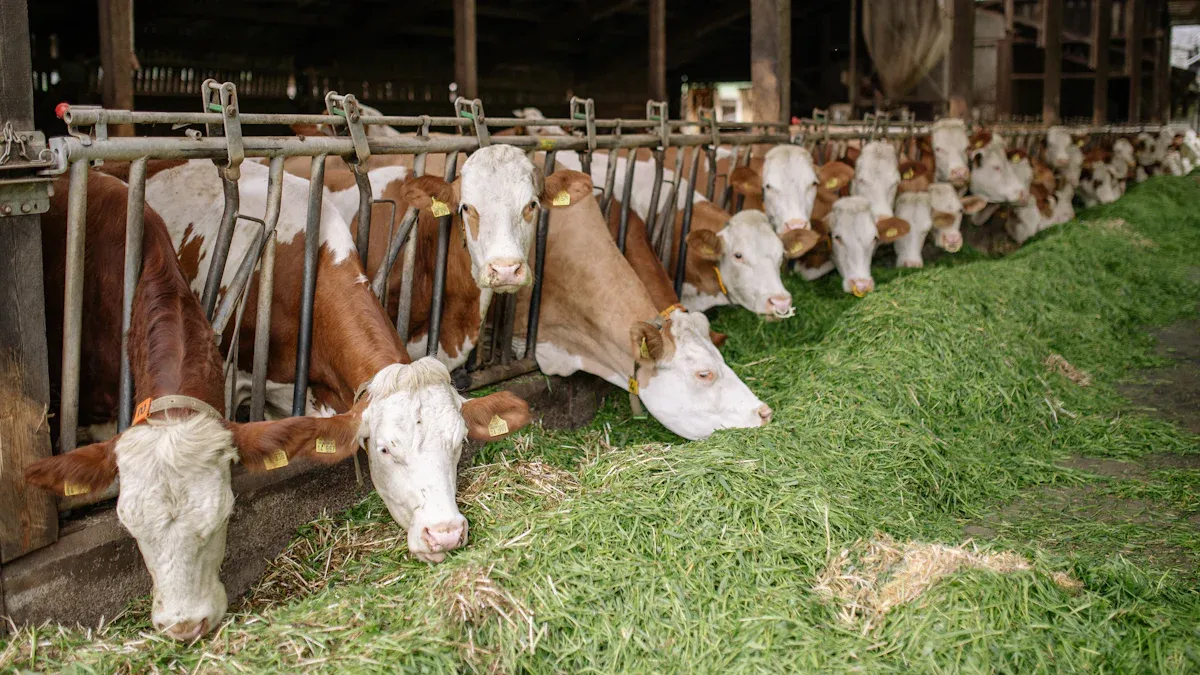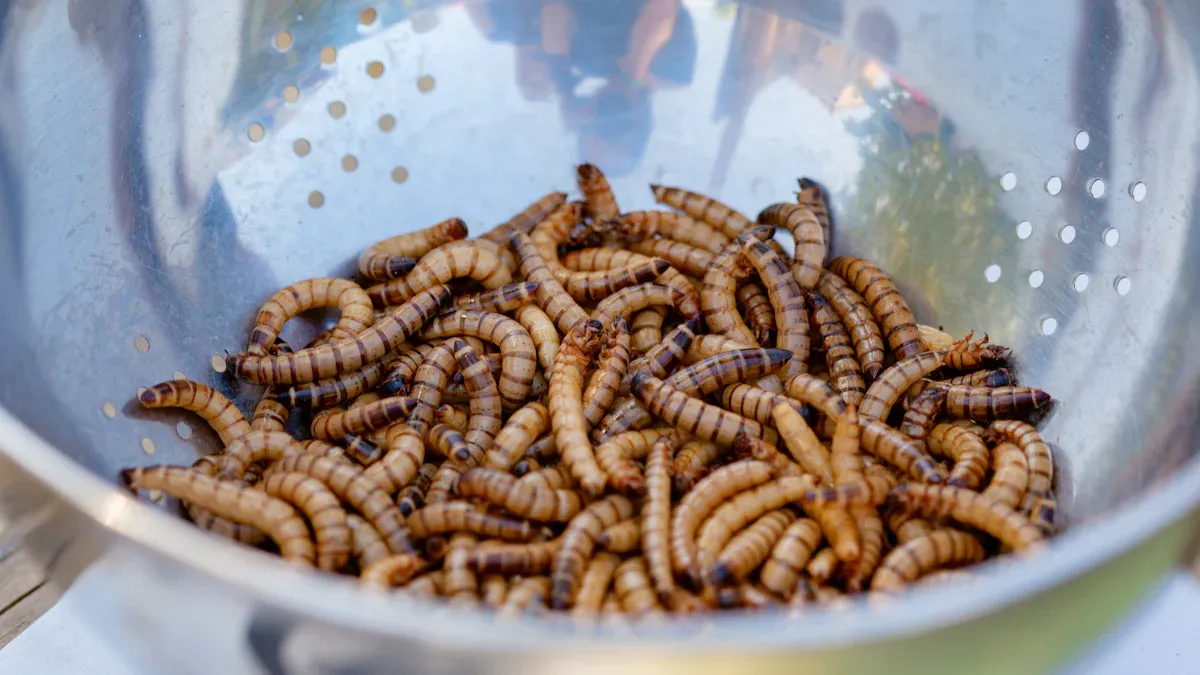
Mealworms are revolutionizing livestock farming! These tiny insects pack a punch when it comes to nutrition and sustainability. Here’s why:
- Their protein content can soar up to 49.46%, depending on their diet.
- They contain beneficial amino acids and bioactive compounds like chitin, which boost immune function.
- Studies show that mealworms enhance gut health, improving livestock well-being.
By including mealworms in feed, farmers can ensure their animals thrive while embracing eco-friendly practices. Mealworms improve livestock quality and pave the way for healthier, more sustainable farming.
Key Takeaways
- Mealworms are a protein-rich food, with nearly 49.46% protein. They help animals grow faster and become stronger.
- Adding mealworms to animal diets improves digestion and strengthens immunity. This makes animals healthier and lowers the need for antibiotics.
- Farming with mealworms helps the environment by cutting waste and gas pollution. It’s a green choice for farmers.
Nutritional Benefits of Mealworms
High Protein Content
Mealworms are protein powerhouses. Their protein levels can reach nearly 50%, making them an excellent feed option for livestock. Protein is essential for muscle growth, repair, and overall development. Animals fed with mealworms grow faster and stronger, which boosts their productivity.
Farmers often look for high-protein feeds to improve livestock quality. Mealworms deliver this in abundance. They provide a natural and efficient way to meet the protein needs of animals without relying on traditional feed sources.
Tip: Including mealworms in livestock diets can significantly enhance growth rates and overall health.
Essential Nutrients
Mealworms aren’t just about protein. They’re packed with essential nutrients like amino acids, fats, and minerals. These nutrients play a vital role in maintaining energy levels, supporting metabolic functions, and improving the overall well-being of livestock.
For example, amino acids found in mealworms help build strong muscles and tissues. Fats provide a concentrated source of energy, which is especially important for animals during colder months or high activity periods. Minerals like zinc and iron contribute to better bone health and immune function.
Farmers who incorporate mealworms into feed notice healthier animals with shinier coats and better stamina. This is another way mealworms improve livestock quality.
Immune System Support
Mealworms contain bioactive compounds like chitin, which strengthen the immune system. A robust immune system helps livestock fight off diseases and recover faster from illnesses. Healthy animals are less likely to require antibiotics or other medical interventions, saving farmers time and money.
Studies show that mealworms also promote gut health. A healthy gut is the foundation of a strong immune system. Livestock with improved gut health digest food better, absorb nutrients more efficiently, and stay healthier overall.
Note: Feeding mealworms regularly can reduce the risk of infections and improve the resilience of livestock.
Environmental Advantages of Mealworms
Sustainability
Mealworms are a sustainable alternative to traditional livestock feed. They require fewer resources to produce and have a much smaller environmental footprint. For example:
- Mealworms emit far less greenhouse gas compared to pigs or cattle. Pigs produce 10–100 times more greenhouse gases per kilogram than mealworms.
- A Dutch study found that mealworm protein generates only half the greenhouse gas emissions of milk, pork, or chicken. It produces just a tenth of the emissions compared to beef.
By choosing mealworms, farmers can significantly reduce their carbon footprint while maintaining high-quality nutrition for their livestock.
Did you know? Mealworms are not only eco-friendly but also help combat climate change by lowering greenhouse gas emissions.
Waste Reduction
Mealworms thrive on organic waste, turning it into valuable protein. They can consume food scraps, agricultural by-products, and even certain types of waste that would otherwise end up in landfills. This ability helps reduce waste while creating a sustainable feed source.
Farmers who use mealworms contribute to a circular economy. Instead of discarding waste, they can repurpose it to grow mealworms, which then nourish their livestock. This process minimizes waste and maximizes resource use.
Resource Efficiency
Raising mealworms is incredibly resource-efficient. They require less water, land, and energy compared to traditional livestock. For instance:
- Mealworms have a water footprint of 4341 m³ per ton, which is similar to chicken but far lower than beef.
- They can be raised in compact spaces, making them ideal for small farms or urban farming setups.
This efficiency allows farmers to produce high-quality feed without depleting natural resources. Mealworms prove that sustainable farming can also be practical and cost-effective.
How Mealworms Improve Livestock Quality

Feeding Strategies
Farmers can use mealworms in various ways to enhance livestock diets. These insects are versatile and can replace traditional protein sources like fishmeal or soybean meal. For instance, mealworm-based meals have proven effective in aquaculture. Studies show that including up to 17% mealworm meal in fish diets supports healthy growth without negative effects. However, exceeding 50% can reduce feed efficiency.
Mealworms also offer high lipid content, which provides energy for animals. But farmers should balance this with other nutrients, especially omega-3 fatty acids, to ensure optimal health. Including mealworms at a 25% level in livestock feed has shown comparable protein efficiency to traditional diets. This makes them a practical and sustainable choice for farmers looking to improve livestock quality.
Tip: Start with small amounts of mealworms in feed and gradually increase to find the best balance for your animals.
Economic Benefits
Switching to mealworms as a feed source can bring long-term economic advantages. While initial costs may seem higher, the benefits outweigh the expenses over time. Mealworms improve feed efficiency, meaning animals grow faster and healthier with less feed. This reduces overall feed costs and boosts productivity.
A study comparing mealworms to traditional fishmeal highlighted their potential for economic and environmental sustainability. Although current costs may not always favor mealworms, advancements in farming technology and increased demand could make them more affordable in the future. Farmers investing in mealworms now are likely to see significant returns as the market evolves.
Practical Applications for Farmers
Farmers can easily integrate mealworms into their operations. These insects are compact and require minimal space, making them ideal for small farms or urban setups. Mealworms thrive on organic waste, so farmers can use food scraps or agricultural by-products to grow them. This reduces waste and creates a circular farming system.
For livestock, mealworms can be fed fresh, dried, or processed into meal. Chickens, fish, and pigs benefit the most from mealworm-based diets. Farmers can also mix mealworms with other feed ingredients to create a balanced diet. By adopting these practices, farmers not only improve livestock quality but also contribute to sustainable farming.
Did you know? Mealworms are a low-maintenance feed option that aligns with eco-friendly farming goals.
Mealworms are transforming livestock farming. They offer superior nutrition, reduce greenhouse gas emissions, and support sustainable practices. Farmers can save costs by replacing traditional feeds like soybean and fishmeal.
| Evidence Type | Details |
|---|---|
| Nutritional Value | Mealworms provide a sustainable protein source for poultry diets. |
| Greenhouse Gas Emissions | Mealworms produce significantly lower greenhouse gas emissions compared to traditional livestock. |
| Economic Benefits for Farmers | Small-scale farmers show interest in rearing mealworms, potentially reducing reliance on soya bean and fishmeal. |
Farmers should embrace mealworms for healthier livestock and eco-friendly farming.
Article by Felix
FAQ
What types of livestock benefit most from mealworms?
Chickens, pigs, and fish thrive on mealworm-based diets. These animals digest mealworms easily and gain essential nutrients for better growth and health.
How can farmers include mealworms in livestock feed?
Farmers can feed mealworms fresh, dried, or ground into meal. Mixing them with other feed ingredients creates a balanced and nutritious diet.
Tip: Start with small amounts and adjust based on livestock needs.
Are mealworms safe for all livestock?
Yes, mealworms are safe for most livestock. They provide high-quality protein and nutrients without harmful additives, making them an excellent feed option.

